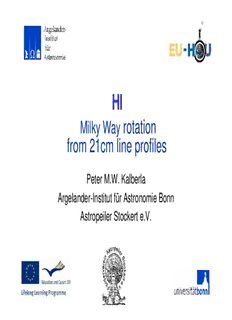
from 21cm line profiles - Argelander-Institut für Astronomie PDF
Preview from 21cm line profiles - Argelander-Institut für Astronomie
HI rotation Milky Way from 21cm line profiles Peter M.W. Kalberla Argelander-Institut für Astronomie Bonn Astropeiler Stockert e.V. Why is HI important? • Hydrogen is the most abundant element • Neutral hydrogen (HI) fills most of the space between the stars • Because of the Doppler effect HI lines supply kinematical information for the observed HI clouds (center velocities), even information about internal motions (profile width) 2 Element abundance, Solar & Cosmic 3 Hydrogen is by far the most abundant element • Very basic ideas: – Assuming that the hydrogen atoms are uniformly distributed throughout the galaxy, we might expect to find hydrogen for each line of sight – Stars are expected to be born out of gas condensations but some gas should have been left over (the interstellar medium, ISM) – Hydrogen is a gas and free to move. This gas however should have settled in the gravitational potential (caused by the stellar disk). In analogy to planetary atmospheres we even might expect to find a “Galactic atmosphere” around the disk. – Line emission would be best for a diagnosis • Each of the observed lines would be Doppler shifted. Hence, one could be able to see the rotation of the Milky. – Radio lines would be important since they would not be obscured by dust 4 The quest for a hydrogen line (1944) • Oort (Professor in Leiden) had spent many years studying the rotation and structure of the Galaxy using optical means. He was frustrated by the extensive clouds of dust lying in the galactic plane, which block visible light. But radio waves will penetrate the dust and show us the galactic center and indeed the opposite side of the galaxy. One can then study the differential rotation of the galaxy and estimate distances to gas clouds, and thus map the distribution of matter in the galaxy. • Radio science has in 1944 advanced to a promising field after detections of radio emission from the Milky Way by Jansky and Reber. • Oort assigned his student, H.C. Van de Hulst, the job of figuring out what radio spectral lines might exist and what their frequencies would be. Since hydrogen is the most abundant element in the universe, he started his studies with hydrogen. He found that a "hyperfine" transition in the ground state of neutral hydrogen would produce radiation in the radio range, at a frequency of 1420 MHz, or about 21 cm wavelength. 5 1944: Van der Hulst reports about the HI line… van de Hulst & Oort http://www.gb.nrao.edu 6 The hyperfine splitting of the ground state 2S is the source of the 21 cm hydrogen line. Frequency 1420.40575177 MHz 7 Properties of the HI 21-cm line • Magnetic dipole emission is a “forbidden” transition. This means, the transition probability is extremely low. • The lifetime of an exited state can be derived from the Einstein coefficient A 10 τ – = 1/ A ~ 3.5·1014 s ~ 11 million years 10 – The frequency is extremely well defined • Observed line reflects motion of the gas (Doppler effect) – Center velocity - rotation curve – radial motion – Line width - temperature and turbulence in the ISM • Excitation by collisions • Line detected 1951 in US, Australia, and the Netherlands 8 “Doc” Ewen – receiver and feed (1951) 9 The potential of 21-cm line data for 3D studies of the Milky Way was realized first by Oort 1958 10
Description: